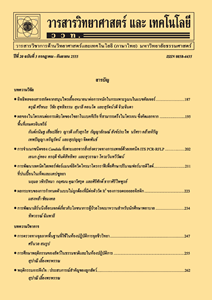Carbon Emission from Maize Cultivation in Dry Season of Thailand
Main Article Content
Abstract
This study was designed as analytical survey research to evaluate carbon emissions from maize cultivation in the dry season of Thailand. Data collection on resources and energy used and product produced was carried out in dominant areas of maize cultivation in Thailand, including Phetchabun, Nan, Loei, Tak, and Chiang Rai provinces. Those selected plantation areas covered 43 % of the total maize cultivation areas of the country. Following a carbon-balanced model, the three main paths of carbon mobilization were identified as carbon emission, fixation, and reduction. Total carbon emissions from maize cultivation in the dry season were found to be 77.38±20.03 kg of CE/rai/season which derived from resources and energy used from field operation. The major sources of emission from plantation activities were fertilizer application and watering process that emitted carbon of 51.04±13.81 and 8.51±2.42 kg of CE/rai, accounting for about 65.96 and 11.00 % of the total, respectively. Meanwhile, the carbon fixation from the main product produces (seed production) was 488±14 kg CE/rai/season, which was higher than that of carbon emission of 6.3 times. In addition, carbon fixation efficiency was computed to be 86.31 %, indicating that maize seed production continues to emit carbon into the atmosphere. However, alternative ways to reduce carbon emission from replacing 50 % of chemical fertilizer with organic fertilizer and replacing all fossil diesel used for agricultural machineries with biodiesel can reduce the carbon emission of 34.42 and 19.85 kg CE/rai/season, respectively. From the selected methods, the potential reduction of carbon emissions from maize cultivation was found to be 70 % as compared to the existing condition.
Article Details
References
Electricity Generating Authority of Thailand, Thailand's Role in Reducing Greenhouse Gases, Available Source: https://www.egat.co.th, September 22, 2019. (in Thai)
ONEP (Office of Natural Resources and Environmental Policy and Planning) 2019, Paris Agreement 2017, Available Source: http://www.onep.go.th, September 22, 2019.
OAE (Office of Agricultural Economics) 2019, Maize: Plantation Area in 2016, Available Source: http://www.oae.go.th, September 22, 2019. (in Thai)
Patthanaissaranukool, W. and Polprasert, C., 2016, Reducing carbon emissions from soybean cultivation to oil production in Thailand, J. Clean. Prod. 131: 170-178.
Patthanaissaranukool, W. and Polprasert, C., 2011, Carbon mobilization in oil palm plantation and milling based on a carbon-Balanced model: A case study in Thailand, Environ. Asia 4(2): 17-26.
Changsaluk, J., 2012, Investigation of Cassava Plantation and Primary Processing in a Carbon-Balanced Model: A Case Study in Thailand, Master Thesis, Mahidol University, Nakhon Pathom.
Neamhom, T., Patthanaissaranukool, W. and Polprasert, C., 2016, Evaluation of carbon equivalences in ethanol production from energy crops in Thailand, GMSARN Int. J. 10: 181-186.
Supasri, T., Intra, P. and Sampattagul, S., 2016, Life Cycle GHGs and PM10 evaluation of maize cultivation in Mae Chaem district, Chiang Mai province, Eng. J. CMU. 23(3): 94-105.
Zhang, W., He, X., Zhang, Z., Gong, S., Zhang, Q., Zhang, W., Liu, D., Zou, C. and Chen, X., 2018, Carbon footprint assessment for irrigated and rainfed maize (Zea mays L.) production on the Loess Plateau of China, Biosyst. Eng. 167: 75-86
Bartlett, J.E., Kotrlik, J.W. and Higgins, C.C., 2001, Organizational research: Determining appropriate sample size in survey research, Inform. Technol. Learn. Perform. J. 19: 43-50.
Patthanaissaranukool, W., Polprasert, C. and Englande, A.J., 2013, Potential reduction of carbon emission from crude palm oil production based on energy and carbon balances, Appl. Energy 102: 710-717.
Pimentel, D., Lal, R. and Singmaster, J., 2010, Carbon capture by biomass and soil are sound: CO2 burial wastes energy, Environ. Develop. Sustain. 201: 447-448.
TCR (The Climate Registry), U.S. Default Factors for Calculating CO2 Emissions from Fossil Fuel and Biomass Combustion, Available Source: https://www.theclimate registry.org/wp-content/uploads/2017/05/2017-Climate-Registry-Default-Emission-Factors.pdf, April 9, 2020.
FAO (Food and Agriculture Organization of The United Nations), 2017, Global Database of GHG Emissions Related to Feed Crops: A Life Cycle Inventory, Version 1, Livestock Environmental Assessment and Performance Partnership, FAO, Rome.
TGO (Thailand Greenhouse Gas Organiza tion), 2020, Emission Factors (Updated on February 2020), Available Source: http://thaicarbonlabel.tgo.or.th/products_emission/products_emission.pnc, April 9, 2020.
Yousefi, M., Damghani, A. and Khoramivafa, M., 2014, Energy consumption, greenhouse gas emissions and assessment of sustain ability index in corn agroecosystems of Iran, Sci. Total Environ. 493: 330-335.
Eranki, P., Devkota, J. and Landis, A., 2019, Carbon footprint of corn-soy-oats rotations in the US Midwest using data from real biological farm management practices, J. Clean. Prod. 210: 170-180
Sureeporn, K. and Napat, J., 2018, Assessment of greenhouses gas emission and mitigation from maize cultivation in Thailand for sustainable production systems, Thammasat Int. J. Sci. Tech. 26(7): 1176-1196.
Nakhon Ratchasima Provincial Agricultural Extension and Development Center (Horticulture), Available Source: http://osd101.ldd.go.th/Q/manual/table_compost.pdf, September 22, 2019. (in Thai)
Polprasert, C., Patthanaissaranukool, W., and Englande, A.J., 2015, A choice between RBD (refined, bleached, and deodorized) palm olein and palm methyl ester productions from carbon movement categorization, Energy 88: 610-620.


